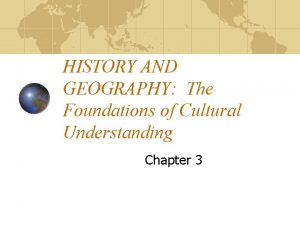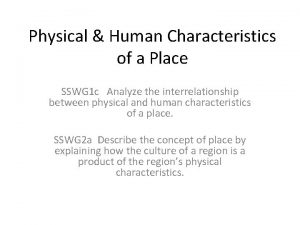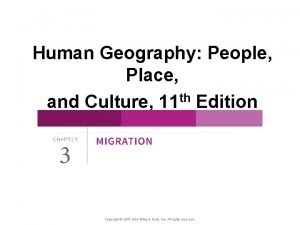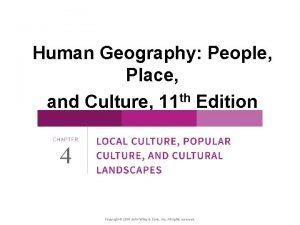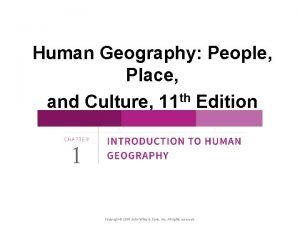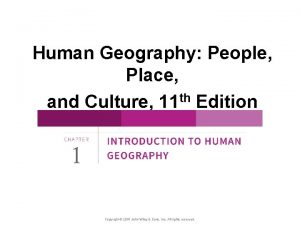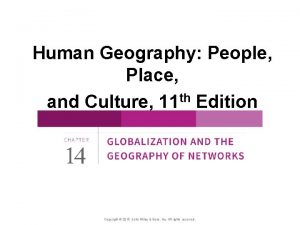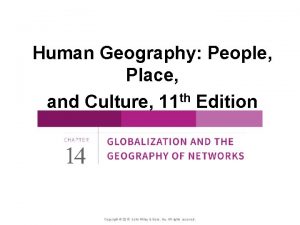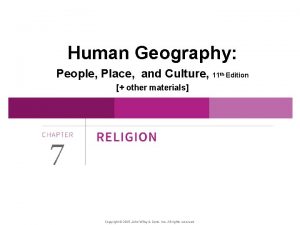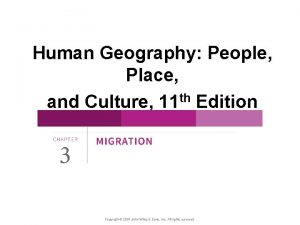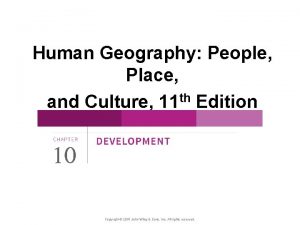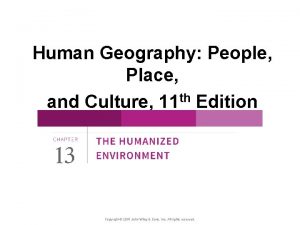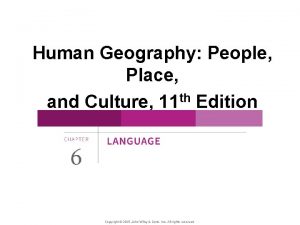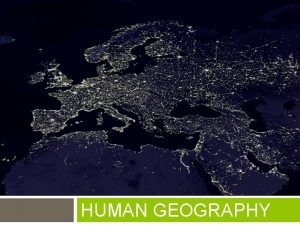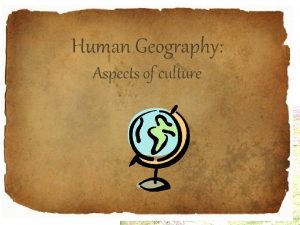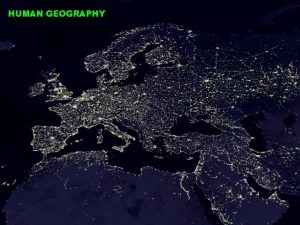Human Geography People Place and Culture 11 th






























- Slides: 30

Human Geography: People, Place, and Culture, 11 th Edition Copyright © 2015 John Wiley & Sons, Inc. All rights reserved.

Chapter 12: Industry and Services Concept Caching: Bicycle Use and Production in China © Barbara Weightman Copyright © 2015 John Wiley & Sons, Inc. All rights reserved.

Key Question: Where did the Industrial Revolution begin, and how did it diffuse? • Eighteenth-century inventions brought new uses for known energy sources (coal) and new machines to improve efficiencies (steam engines). Copyright © 2015 John Wiley & Sons, Inc. All rights reserved.

The Industrial Revolution • Manufacturing enabled the production of the steam engine and a variety of other products. • An expanding trade network focused on Western Europe and brought wealth to those in a position to take advantage of changing circumstances. • Railroad and steam ship heightened advantage. Copyright © 2015 John Wiley & Sons, Inc. All rights reserved.

Diffusion to Mainland Europe Concept Caching: Fenway Park, Boston, MA • Diffused through port cities and near coal fields. • Developments changed the port cities. • Railroad network expanded inside of existing urban areas with large markets, i. e. London and Paris. Copyright © 2015 John Wiley & Sons, Inc. All rights reserved.

Diffusion Beyond Europe • Primary industrial regions: western Europe, eastern North America, western Russia and Ukraine, and East Asia • North America: Manufacturing began in New England during the colonial period; benefited from the ability of its companies to acquire needed raw materials from overseas sources. • Russia and Ukraine: St. Petersburg attracted industries including shipbuilding, chemical production, food processing, and textile making. • East Asia: manufacturing in Japan depended on raw materials imported from other parts of the world; dominant region is the Kanto Plain. Copyright © 2015 John Wiley & Sons, Inc. All rights reserved.

Examine the map of diffusion of the Industrial Revolution into Europe (Fig. 12. 5) and hypothesize what other characteristics (aside from the presence of coal) were necessary for industrialization to take hold in these regions. Copyright © 2015 John Wiley & Sons, Inc. All rights reserved.

Key Question: How have the character and geography of industrial production changed? • Fordist production: was the dominant mode of mass production that endured from 1945 to 1970, named for Henry Ford. • The Fordist period is marked by a surge in both mass production and mass consumption. • Vertical integration • Friction of distance: the increase in time and cost that usually comes with increased distance over which commodities must travel. Ex. : furniture manufacturing Copyright © 2015 John Wiley & Sons, Inc. All rights reserved.

Agglomeration • British economist Alfred Marshall: localization • Geographer Alfred Weber: least cost theory focused on a factory owner’s desire to minimize three categories of costs: 1. Transportation 2. Labor 3. Agglomeration Copyright © 2015 John Wiley & Sons, Inc. All rights reserved.

Flexible Production and Product Life Cycle • Flexible production systems: Firms can pick and choose among a multitude of suppliers and production strategies in distant places, and then quickly shift their choices in response to adjustments in production costs or consumer demand. • Commodification: Goods that were not previously bought, sold, and traded gain a monetary value and are bought, sold, and traded on the market. • Product life cycle: Changes in the production of a good over time take place. Copyright © 2015 John Wiley & Sons, Inc. All rights reserved.

The Global Division of Labor • Labor is concentrated in the global economic periphery and semiperiphery to take advantage of lower labor costs, whereas research and development is primarily located in the core. • David Harvey: time–space compression. • Just-in-time delivery: Companies keep just what they need for short-term production and new parts are shipped quickly when needed. • Spatial fix: In choosing a production site, location is only one consideration. • Outsourced: moved offshore. Copyright © 2015 John Wiley & Sons, Inc. All rights reserved.

Made in America or Designed in America? • Commodity Chain: Consumption, or purchasing an item, is the end point in a commodity chain that affects places in a variety of ways. Copyright © 2015 John Wiley & Sons, Inc. All rights reserved.

Major Influences on the Contemporary Geography of Manufacturing • Transportation: Intermodal connections, places where two or more modes of transportation meet in order to ease the flow of goods and reduce the costs of transportation. • Regulatory Circumstances: Regional trade organizations such as the North American Free Trade Agreement (NAFTA) and the European Union (EU) have trade agreements that influence where imported goods are produced. • Energy: The role of energy supply as a factor in industrial location decisions has changed over time. Copyright © 2015 John Wiley & Sons, Inc. All rights reserved.

New Centers of Industrial Activity • Deindustrialization is a process by which companies move industrial jobs to other regions. • New industrial regions emerge as shifts in politics, laws, capital flow, and labor availability occur. • East Asia has become a particularly important new region of industrialization. Copyright © 2015 John Wiley & Sons, Inc. All rights reserved.

New Centers of Industrial Activity The Rise of East Asia • Four Tigers of East and Southeast Asia: South Korea, Taiwan, Hong Kong, and Singapore. • The tigers emerged as the first newly industrializing countries (NICs). • Hong Kong became mainland China’s gateway. • To the world, a bustling port, financial center, and breakof-bulk point, where goods are transferred from one mode of transport to another. Copyright © 2015 John Wiley & Sons, Inc. All rights reserved.

New Centers of Industrial Activity The Rise of East Asia • The industrial growth of Singapore also was influenced by its geographical setting and the changing global economic division of labor. • In 1997 risky lending practices and government investment decisions caused Thailand’s currency to collapse, followed by its stock market. • By early 1998 one of the Four Tigers, South Korea, required a massive infusion of dollars to prevent economic chaos. Copyright © 2015 John Wiley & Sons, Inc. All rights reserved.

New Centers of Industrial Activity The Chinese Juggernaut • China’s major industrial expansion occurred during the communist period. • Under state planning rules, the Northeast district became China’s industrial heartland, a complex of heavy industries based on the region’s coal and iron deposits located in the basin of the Liao River. • The second largest industrial region in China, the Shanghai and the Chang Jiang district , developed in and around the country’s biggest city, Shanghai. Copyright © 2015 John Wiley & Sons, Inc. All rights reserved.

New Centers of Industrial Activity The Chinese Juggernaut • China’s large labor force has attracted hundreds of international companies. • The Northeast has become China’s “Rust Belt. ” • Today, the Chinese government is pushing industrialization into the interior of the country, with new investment flowing into poorer parts of the central and western portions of the country. Copyright © 2015 John Wiley & Sons, Inc. All rights reserved.

New Centers of Industrial Activity The Chinese Juggernaut • BRICS: Brazil, Russia, India, China, and South Africa; these countries are evidence of a shift in global economic power away from the traditional economic core. • India has recently become the world’s sixth largest economy. • India has no major oil reserves, so it must spend heavily on oil energy. Copyright © 2015 John Wiley & Sons, Inc. All rights reserved.

New Centers of Industrial Activity Where From Here? • It has been suggested that a combination of technological changes and developments in the global economy have reduced the significance of location and made place differences increasingly insignificant. • What is needed is a greater understanding of how places have changed as a result of new production methods, new corporate structures, and new patterns of industry. Copyright © 2015 John Wiley & Sons, Inc. All rights reserved.

Key Question How have deindustrialization and the rise of service industries altered the economic geography of production? Copyright © 2015 John Wiley & Sons, Inc. All rights reserved.

Key Question: How Have Deindustrialization and the Rise of Service Industries Altered the Economic Geography of Production? • Service industries (tertiary industries) encompass the range of services that are found in modern societies. • Quaternary industries: the collection, processing, and manipulation of information and capital. • Quinary industries: activities that facilitate complex decision making and the advancement of human capacities. Copyright © 2015 John Wiley & Sons, Inc. All rights reserved.

Geographical Dimensions of the Service Economy • Deindustrialization did little to change the basic disparities between core and periphery that have long characterized the global economy. • The industrial zone of the northeastern United Caching: Lakes) lost much of its States (around. Concept the Great Mount Vesuvius industrial base and is now commonly called the Rust Belt. • The Sun Belt is a secondary industrial region that has made the transition to a viable service economy fairly successfully. Copyright © 2015 John Wiley & Sons, Inc. All rights reserved.

Geographical Dimensions of the Service Economy New Patterns of Economic Activity • Technologies such as GIS can help to model the best locations for new businesses, office complexes, government centers, or transportation connections. • Major retailers change the economic prospects and physical landscapes of the places where their headquarters are located. Ex. : Walmart • The locational influences on quaternary services are more diverse. • Those who work in the quinary sector tend to be concentrated around governmental seats, universities, and corporate headquarters. Copyright © 2015 John Wiley & Sons, Inc. All rights reserved.

High-Technology Clusters • The goal of a high-technology corridor is to attract designers of computers, semiconductors, telecommunications, sophisticated medical equipment, etc. Ex. : California’s Silicon Valley • Growth pole spurred economic development in the surrounding area. • Technopole: an area planned for high technology where agglomeration built on a synergy among technological companies occurs. • High-technology industries have become such an important symbol of the postindustrial world that local, regional, and national governments often aggressively pursue firms in this sector. Copyright © 2015 John Wiley & Sons, Inc. All rights reserved.

Figure 12. 25 Plano-Richardson, Texas. The Plano-Richardson Telecom Corridor is located just north of Dallas and is home to telecom corporate headquarters, such as Electronic Data Systems Corporation’s headquarters in this photograph Copyright © 2015 John Wiley & Sons, Inc. All rights reserved.

Tourism Services • The tourism boom began in the global economic core as incomes and leisure time increased for a rapidly expanding segment of the population. • Tourism is likely to continue to expand despite dips in travel at the beginning and end of the first decade of the twenty-first century. • The economic impacts of tourist-related development are far-reaching. Copyright © 2015 John Wiley & Sons, Inc. All rights reserved.

Place Vulnerabilities in a Service Economy • Mechanization can have a negative impact on service jobs. • Places dominated by the service sector cannot exist without extensive connections with other places because those living in such places still need food and material products. • Economic decision making in a globalized economy can easily become disconnected from the fate of individual places and regions. • Ex. : the financial services industry Copyright © 2015 John Wiley & Sons, Inc. All rights reserved.

How does a place change when deindustrialization occurs? Consider a place that has experienced deindustrialization, and research recent news articles on the Internet to find out how the economy of the place has changed since the loss of industry. What has happened to the place and its economy? Copyright © 2015 John Wiley & Sons, Inc. All rights reserved.

Additional Resources • Port of Rotterdam http: //www. portofrotterdam. com • Nike http: //www. nikebiz. com/company_overview • Walmart’s influence on Bentonville, Arkansas http: //www. pbs. org/wgbh/pages/frontline/shows/walmart Concept Caching: Mount Vesuvius • Additional Resources on Geography Education – Industry, Labor, Manufacturing, Globalization, Diffusion, Economic. Copyright © 2015 John Wiley & Sons, Inc. All rights reserved.
 Habit ap human geography
Habit ap human geography What is the range for an ikea store ap human geography
What is the range for an ikea store ap human geography Folk vs pop culture
Folk vs pop culture How to write an frq for ap human geography
How to write an frq for ap human geography 5 themes of geography ap human geography
5 themes of geography ap human geography Stateless nation
Stateless nation Human development index definition ap human geography
Human development index definition ap human geography Place place value and period
Place place value and period Relativism
Relativism Batch culture vs continuous culture
Batch culture vs continuous culture American culture vs indian culture
American culture vs indian culture Uses of selenite f broth
Uses of selenite f broth Folk culture and popular culture venn diagram
Folk culture and popular culture venn diagram Examples of mass culture
Examples of mass culture Site:slidetodoc.com
Site:slidetodoc.com Folk culture and popular culture venn diagram
Folk culture and popular culture venn diagram Carpet culture method
Carpet culture method Lawn or carpet culture method
Lawn or carpet culture method Surface culture deep culture and esol
Surface culture deep culture and esol People as media and people in media examples
People as media and people in media examples History and geography the foundations of culture
History and geography the foundations of culture Taliban vs western values ap human geography
Taliban vs western values ap human geography Repeating disturbance that transfers energy
Repeating disturbance that transfers energy A disturbance that transfers energy
A disturbance that transfers energy Physical and human characteristics
Physical and human characteristics Sociologists define a symbol as
Sociologists define a symbol as Batch culture vs continuous culture
Batch culture vs continuous culture Collectivistic cultures
Collectivistic cultures Counterculture vs subculture
Counterculture vs subculture Inert organizational culture
Inert organizational culture Quality culture vs traditional culture
Quality culture vs traditional culture




















